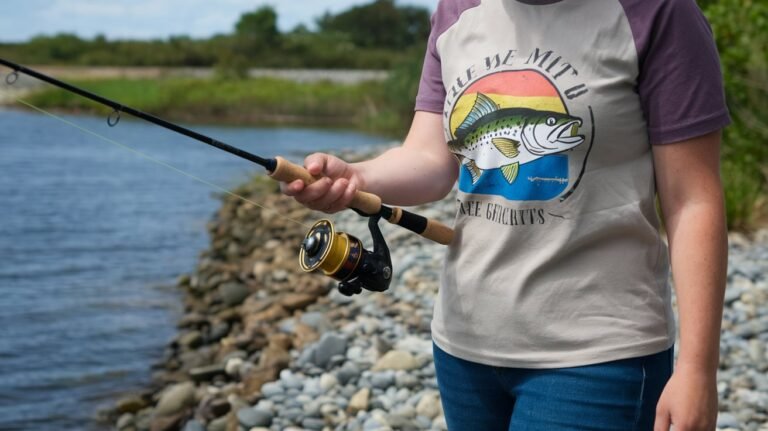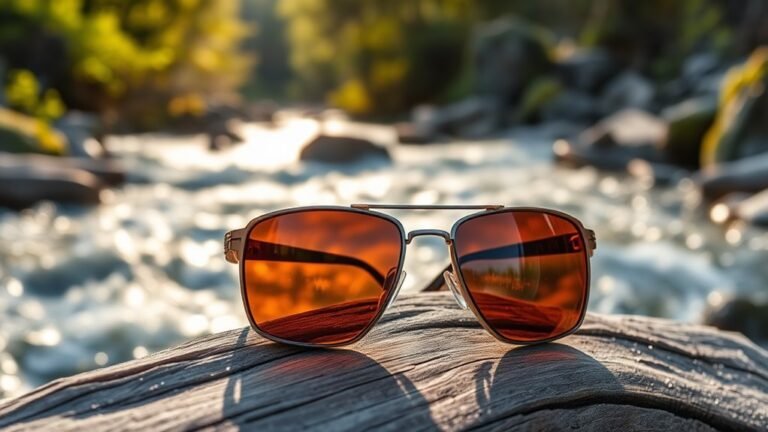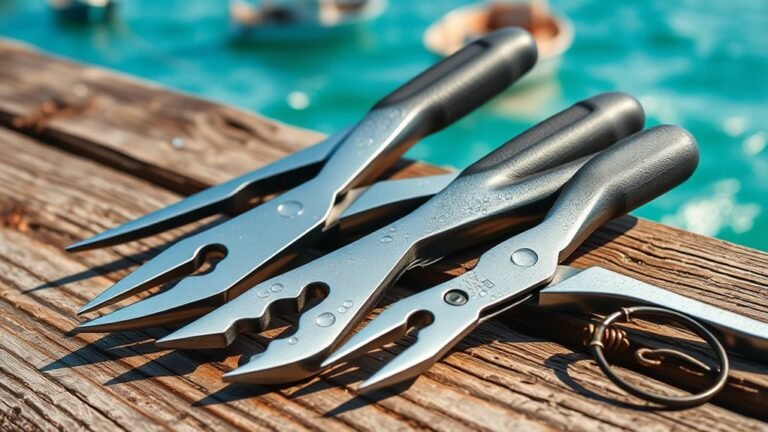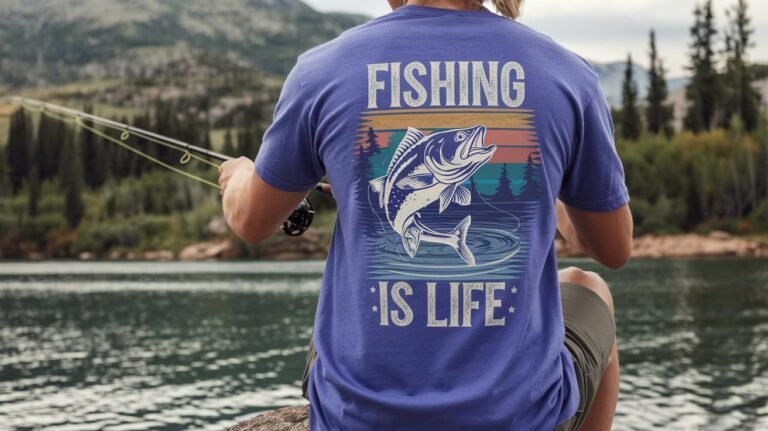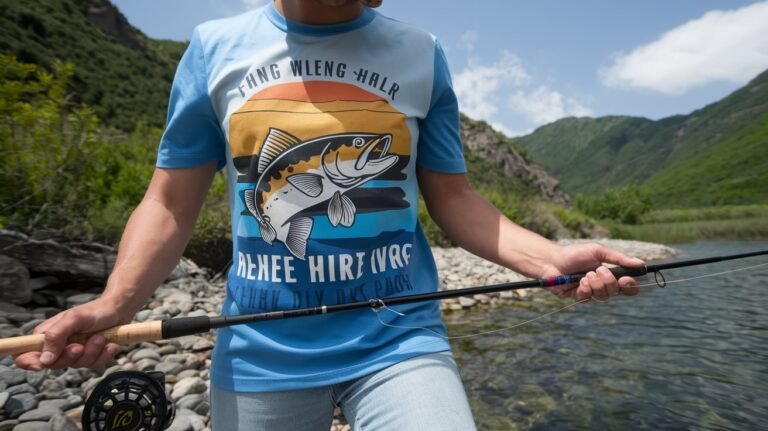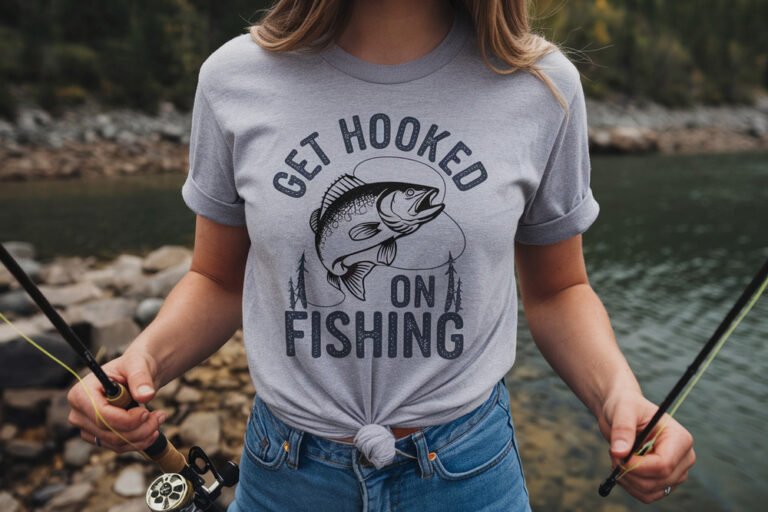3 Best Nippers for Fly Fishing
Using a basic nail clipper for trimming fishing line can result in frayed lines and lost catches.
Dedicated fly fishing nippers are essential tools that enhance your experience on the water.
Each nipper varies in features, such as ergonomic grips and built-in needle tools.
To protect your investment in quality line and flies, it's important to distinguish the best nippers from the mediocre ones.
Key Takeaways
- Loon Fly Fishing Classic Nipper stands out with surgical-quality steel blades and integrated eye-clearing needle for versatile performance.
- Umpqua Rivergrip PS Big Nipper features an ergonomic design with thumb-bump grip and rotating ring attachment to prevent loss.
- High-quality nippers should have stainless steel construction, replaceable blades, and corrosion resistance for long-term durability.
- Ergonomic handles and non-slip grips are essential features for comfort during extended use in wet conditions.
- The Umpqua Rivergrip PS Zinger Nipper Combo combines retractable zinger functionality with efficient cutting performance in multiple color options.
Loon Fly Fishing Classic Nipper with Comfy Grip
Prices pulled from the Amazon Product Advertising API on:
Product prices and availability are accurate as of the date/time indicated and are subject to change. Any price and availability information displayed on [relevant Amazon Site(s), as applicable] at the time of purchase will apply to the purchase of this product.
The Loon Fly Fishing Classic Nipper is designed for anglers valuing comfort during long sessions. Its distinctive yellow grip ensures secure handling even when wet, and the surgical-quality steel blades provide reliable cuts. The tool's integrated eye-clearing needle enhances its versatility.
Weighing just 0.01 kilograms and measuring 6 x 4 x 1 inches, the nipper is unobtrusive. It effectively cuts most fishing lines but may not be ideal for braided lines. Although the lanyard attachment helps prevent loss, some users suggest reinforcing it due to potential durability concerns.
This nipper is best for fly fishing enthusiasts using standard lines, offering comfort and functionality. Pros include a secure grip, sharp cuts, and added versatility from the needle. Cons involve potential lanyard durability issues, inefficiency with braided lines, and a higher price compared to basic nippers.
Umpqua Rivergrip PS Big Nipper
Prices pulled from the Amazon Product Advertising API on:
Product prices and availability are accurate as of the date/time indicated and are subject to change. Any price and availability information displayed on [relevant Amazon Site(s), as applicable] at the time of purchase will apply to the purchase of this product.
Anglers will appreciate the precision cutting of the Umpqua Rivergrip PS Big Nipper, designed with an ergonomic cut-out and thumb-bump for a secure grip while trimming tippet, leader, and fishing line. The free-rotating ring attachment is ideal for securing the nippers to your gear, preventing loss on the water. Additionally, the integrated pin eye-cleaner allows you to clear blocked hook eyes without needing another tool.
Its red color makes it easy to spot, and the compact size of 5.16 x 3.5 x 0.55 inches ensures it won't occupy much space. Weighing just 0.04 kilograms, it's lightweight enough to hang unnoticed until needed. This tool is perfect for fly fishing enthusiasts who require a reliable and ergonomic cutting tool while maintaining mobility.
Pros:
- Ergonomic design with thumb-bump for a secure grip
- Free-rotating ring attachment for easy access and loss prevention
- Integrated pin eye-cleaner for added functionality
Cons:
- Higher cost compared to basic nippers
- Limited customer reviews make reliability hard to assess
- Larger packaging dimensions (13 x 10 x 1 inches) may be bulky for some vests
Umpqua Rivergrip PS Zinger Nipper Combo
Prices pulled from the Amazon Product Advertising API on:
Product prices and availability are accurate as of the date/time indicated and are subject to change. Any price and availability information displayed on [relevant Amazon Site(s), as applicable] at the time of purchase will apply to the purchase of this product.
The Umpqua Rivergrip PS Zinger Nipper Combo is a versatile tool for keeping line-cutting tools within reach. It combines a retractable zinger and line-cutting nipper in one package, available in Black, Red, or Hot Orange. Ideal for fly fishing, it clips easily to your vest or pack, ensuring quick access without weighing you down, as it measures 6.26 x 4.49 x 1.1 inches and weighs just 0.05 kilograms. This compact combo keeps essential tools handy, enhancing mobility on the stream.
Best For: Fly fishing enthusiasts needing quick access to line-cutting tools.
Pros:
- Convenient retractable zinger and nipper
- Multiple color options
- Lightweight and compact
Cons:
- Low Best Sellers Rank
- Single-function may not suit casual anglers
- Bulky packaging compared to product size
Factors to Consider When Choosing Nippers for Fly Fishing
When you're selecting fly fishing nippers, you'll need to evaluate several critical features that directly impact their performance on the water. The quality of the cutting edge material, ergonomic grip design, and overall size and weight balance will determine how effectively you can manage your line and tackle while fishing. Your choice should also account for attachment options and the nipper's ability to withstand constant exposure to water, as these factors affect both convenience and long-term durability.
Cutting Edge Material Quality
The material quality of fly fishing nippers is crucial for a successful experience. Surgical-grade steel is preferred by serious anglers for its sharpness and durability, ensuring consistent performance. High-quality steel maintains a straight edge for clean cuts, making knot tying more efficient and secure.
Premium nippers often have hardened steel blades that resist dulling and corrosion, even with frequent use in harsh environments. Material quality also affects additional functions, like clearing line guides with built-in needles. Superior materials, combined with ergonomic designs like comfortable grips and rotating rings, enhance overall functionality and control in wet conditions.
Grip and Handling Design
When selecting fly fishing nippers, prioritize proper grip and handling design. Ensure the grip is comfortable and non-slip, especially in wet conditions where control is crucial. Ergonomic features like thumb bumps and cut-outs help reduce hand fatigue during long sessions.
Opt for rubberized or textured surfaces for better traction, and consider nippers with free-rotating attachment points for improved maneuverability. The grip size is vital; it should fit your hand comfortably without causing strain. High-quality grip materials are essential for durability and performance, enduring frequent water exposure and repeated use across fishing seasons.
Size and Weight Balance
For optimal fly fishing, selecting nippers with the right size and weight balance is essential. Aim for nippers measuring 5 to 7 inches in length for excellent handling and effective cutting. The weight should be between 0.01 to 0.05 kilograms to prevent hand fatigue during long fishing sessions.
Consider how the nippers fit in your vest or pocket; a compact 5 to 6 inches is ideal for easy storage and access. Pay attention to weight distribution to prevent slipping, especially in wet conditions. Choose models that feel comfortable and provide stability without being cumbersome, ensuring precise cuts and effective handling.
Attachment and Storage Options
Smart attachment and storage solutions are crucial for an efficient fishing experience. Opt for nippers with a lanyard or retractable zinger to keep them secure and easily accessible. Free-rotating ring attachments prevent tangling, and models with vest or pack attachment points ensure your tools are always within reach.
Choose nippers with a compact 5 to 6-inch profile to fit comfortably in vest pockets or attach without bulk. Prioritize ergonomic features like thumb bumps and cut-out handles for a secure grip, even in wet conditions, while ensuring the nippers stay firmly attached.
Durability Under Wet Conditions
Water poses challenges for fly fishing gear, making durable nippers essential. Opt for those made from surgical quality steel for rust and corrosion resistance, ensuring cutting effectiveness after repeated water exposure. Prioritize nippers with secure grips for wet conditions and a free-rotating ring to prevent wear and tangles.
Choose models with eye-clearing needles to clear debris and maintain cutting efficiency. Don't overlook cable attachment quality, as some materials can degrade with moisture and strain. Selecting nippers with these features ensures reliability in all fishing conditions.
Price Versus Performance Value
Choosing nippers based solely on price can lead to disappointment. While affordable options are available, assess their performance in essential cutting tasks and long-term value. Higher-priced nippers often offer superior cutting capabilities and materials that maintain sharpness over time.
Evaluate customer ratings and reviews to understand how different models handle materials like tippet or braid. Ergonomic designs, though pricier, can enhance your fishing experience by reducing hand fatigue. Consider additional features, such as built-in eye-cleaning needles or secure attachment systems, that might justify a higher price.
Research the manufacturer's reputation in the fly fishing community before deciding. Established brands may charge more but typically offer better reliability and performance. Balance your budget with factors like cutting efficiency, comfort, and durability to find the best value for your needs.
Frequently Asked Questions
Can I Sharpen Dull Fly Fishing Nippers to Extend Their Life?
You can sharpen dull fly fishing nippers, but it's tricky and might not be worth the effort. To attempt it, you'll need a small diamond file or ceramic sharpening stone. Work carefully on the beveled edge while maintaining the original angle. However, since nippers have precisely manufactured cutting edges and often feature specialized coatings, sharpening them yourself could compromise their performance. It's usually better to replace them when they become dull.
How Often Should Fly Fishing Nippers Be Replaced?
You'll need to replace your fly fishing nippers when they show signs of dullness, rust, or mechanical failure, typically every 1-2 seasons with regular use. If you're fishing 2-3 times per week, you might need to replace them annually. You can extend their lifespan by cleaning them after use, storing them in a dry place, and applying light oil to prevent rust. However, don't wait too long, as dull nippers can damage your line.
Are Magnetic Nippers Worth the Extra Cost for Fly Fishing?
Like a trusty compass guiding you through the wilderness, magnetic nippers can be a valuable addition to your fly fishing gear. They're worth the extra cost if you frequently fish alone, as they'll keep your nippers secured to your vest and easily accessible. You'll appreciate the convenience of not having to fumble through pockets or worry about dropping them in the water. However, standard nippers work just fine if you're careful with your gear.
What's the Best Way to Prevent Nippers From Rusting?
To prevent your nippers from rusting, you'll need to follow a few key maintenance steps. After each use, rinse them thoroughly with fresh water and dry them completely with a clean cloth. You can apply a light coat of mineral oil or WD-40 to create a protective barrier against moisture. When storing your nippers, keep them in a dry place, and consider using a silica gel packet to absorb any residual moisture.
Can I Use Regular Nail Clippers Instead of Fly Fishing Nippers?
Like using a butter knife as a screwdriver, you can use nail clippers for fly fishing, but you won't get ideal results. While nail clippers might work in a pinch, they're bulkier and less precise than dedicated fishing nippers. You'll struggle to make clean cuts on fine tippet material, and they're not designed to handle the constant exposure to water and salt. Plus, they lack essential features like hook-eye cleaners and retractor attachments.
Conclusion
Choosing the right nipper can significantly enhance your fly fishing experience. The Loon Classic's ergonomic design is perfect for prolonged use, while Umpqua offers convenience without compromising quality. Consider how often you'll use them, your storage needs, and your budget. Investing in quality nippers will lead to better performance and increased durability on the water.


